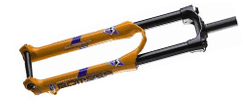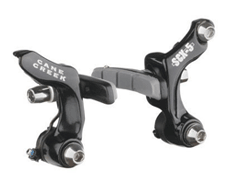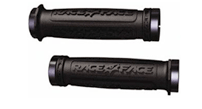MOUNTAIN BIKE GUIDE
Buying a mountain bike (also known as cross country, off road, all terrain or trail bike) is exciting but sometimes confusing. From an entry level off road bicycle to a high performance downhill model with full suspension, there is a wide choice of frames, components and sizes. Our informative buyers guide will steer you through the maze and offer sound advice direct from experienced riders and mechanics.Front & Rear MTB Suspension
Suspension is added to mountain cycles to cushion the impact of rocks, tree roots and other commonly encountered obstacles. The shock absorbing quality ensures that the wheels maintain contact with the ground as much as possible. These benefits make this type of riding a more pleasurable experience.

- -Your arms won't get tired so quickly.
- -The bicycle is easier to control.
- -You are more comfortable on the saddle.
- -You can keep riding longer with less fatigue.
There are two suspension options to choose from: front suspension only ('hardtail' bike) or both front and rear suspension ('full suspension' bike). Either option provides an excellent choice for leisurely off road riding. Full suspension cycles provide an extra comfortable ride and are better at handling mistakes. Conversely, hardtail bikes are lighter, less expensive and easier to maintain. We recommend you speak to an AW Cycles Mountain Bike expert about your preferences, experience and the type of riding you will be doing.
Cross Country Racing
For cross country mountain bike racing, a hardtail is often preferable as it is lighter, more responsive and has less working parts that could go wrong. However, a particularly technical course makes a full suspension bike the faster option. Experienced racers will usually own both models choosing the most appropriate for each course and riding conditions.
The degree of suspension varies widely. At entry level, 3-5 inches of rear suspension is common. A bicycle with 5-7 inches of travel is a perfect trail cycle and could be used for downhill riding. A purpose built downhill bike is likely to have seven inches of travel or more and is designed with ultimate suspension efficiency.
Choosing Brakes For Your MTB
There are three main choices of mountain cycle braking systems; V-Brakes, cable disc brakes and hydraulic disc brakes. If you are buying a new bike then the chances are that one of these brake systems will be fitted.
V-Brakes are operated via pads applied directly to the rim. They are the lightest choice but perform less well than more expensive disc brake systems. Typically they are found on entry-to-mid level MTBs because they are simple, light and cost effective. Some high performance racers opt for this type to reduce the weight of their bicycle. The jury is out as to whether the trade off between performance and weight is worthwhile. Elite racers are divided in opinion and races are regularly won by followers of both systems.

For maximum performance and control, disc brakes using cables or a hydraulic system are the ideal choice. Working in the same way as motorbike brakes, these provide excellent stopping power in all conditions and are not badly affected by water and mud.
The braking surface is provided by a disc attached to the hub of specially manufactured wheels. Similarly, if you buckle your wheel the brakes will continue to work safely. A hydraulic action means that riders needn't worry about snapping or wearing cables. Disc brakes are relatively maintenance free, although they are heavier and more expensive than V-Brakes.
Brake levers usually come as part of the main system, although there can be exceptions. People with small hands such as youngsters and ladies may get along better with specifically designed levers. We recommend sticking with the brake levers that are intended for use with the system on your bicycle.
Finding A Frame
Most mountain bikes are currently manufactured from various grades of aluminium. As technology advances, other materials are becoming increasingly popular, such as aluminium alloys (e.g. scandium) and carbon. As the main limitation of full suspension bikes is weight, choosing a frame made from a lighter material, such as carbon will reduce weight without compromising the handling and performance.
Titanium frames are beginning to enter the market and offer high strength, longevity and low weight. Many of these frames are sold with a 50 year warranty but be warned, serious durability comes at a price!
The Different Brands
At AW Cycles, our mountain bike experts have hand picked a selection of brands which reflect the widest range of styles and qualities of MTBs on the market. Here are some leading brands to look out for:
 Giant
Giant
The biggest bicycle manufacturer in the world with the greatest buying power in the entire industry. Giant bikes always represent great value for money. In addition, this company has never been afraid to try out new ideas, setting aside a hefty R&D budget to fully develop and test cutting edge technology.
Mountain Bike History
Mountain biking started in the early 1980s in the United States. Free from many of the traditional elements of the sport, these early pioneers built bikes MTBs from bits and pieces of other bicycles. They tried many different designs and pieces of equipment until they were happy with them.
The speed at which the components were developed has meant that most of the advances were rolled out quickly, similar to the way road bicycles were developed in the 1960s. Finger tip gear controls, 2 finger brakes and indexed gears were all available within a couple of years of the first mountain bikes hitting the shops. The standard for MTBs was set much higher than with road models.
Innovation of Components
It is only in the last 15 years that road bicycles have had indexed gears and handlebar gear controls, whereas mountain bikes offer these as standard. This has meant that innovation has taken place in other areas and resulted in mountain bikes being more technologically advanced than their road based counterparts. Recent advances, such as hydraulic braking and full suspension systems have also enabled specialist manufacturers to challenge the established dominance of Shimano. Our experienced sales team can advise you on the most suitable model for your intended use and help you with any specialist upgrades or equipment changes that you may be considering.
Groupsets
Unlike road cycling, mountain biking is dominated by one manufacturer. Shimano of Japan supplies practically every manufacturer with components, from entry level to top of the range. Similarly to road bikes, the higher up the price scale you go, more specialist component manufacturers come to the fore. The newest manufacturer in the road bicycle market, SRAM have been established for some time now and are seen as a distinct alternative to the Japanese dominance.
The Main Players
When buying an MTB the chances are that it will be equipped with components from one of these 2 manufacturers. Gear and brake control for mountain bikes are all accessible from the general hand position whilst riding. The type of brake control is common across all manufacturers for either cable or hydraulic systems. Gear control is quite different - with a choice of either twist shifting, trigger shifting and dual control, most people will be able to find a method that they like and are able to use comfortably.
Gear Systems
Even though they are newer to the market than Shimano, SRAM have established themselves as a serious alternative. With their innovative design and functional performance, there is very little to choose from between the 2 brands. Most gear systems consist of 9 sprockets at the back and 3 chain-rings at the front. Even though road gear systems have evolved to 10 at the rear, the gap is small enough for the gears to be affected by mud build up. The choice of 27 gears is more than enough for any situation without feeling the need for any more!
MTB Chainsets
As the central component of the bicycle's drive train, it is important to make sure you have as good a chainset as possible. A sealed bottom bracket is standard 'must have' feature on any mountain bike bearing system. It is generally accepted to use a slightly longer crank length on a mountain bike, due to the extra leverage this and the resulting benefits.
Regular Maintenance
One component that is important to keep well maintained and worth an upgrade is gear and brake cables / hoses. A high quality gear cable will ensure smooth, problem free shifting and will last many hours of riding in inclement conditions. Likewise, specialist brake hoses offer many hours of reliable braking and optimum performance.

Pedal Designs
Off road cycling will generally consist of plenty of riding and to a certain extent some walking! You may be able to use road shoes or even trainers but in order to maximise your riding experience, we recommend using dedicated off-road shoes. Clip and strap pedals or clipless pedals are both usable on a mountain bicycle but to get the most enjoyment out of your riding, clipless designs are a must. These are generally small pedals with double sided release mechanisms and easy mud clearance. With a little practice it is possible to easily jump on and off the bike when necessary and clip in and out with little difficulty. We stock off road pedals by Shimano, Time, Crank Brothers, Speedplay and Xpeda as well as a range of bear-trap style pedals for riders without the confidence to use clipless pedals.
Forks & Shocks
In order to cope with both on and off road terrain, mountain bikes have for many years now been fitted as standard with front suspension forks. These are the same as the forks you will see on most motorbikes and work on a spring or oil damping system. As you would expect, the performance and function is variable between models. Our tables should help you decide which model is best suited to your individual needs and budget.
Handlebars and Stems
In order to remain in a comfortable and efficient position, MTB handlebars are flat with varying degrees of rise and curve. It is important to ensure that your hands are in a relaxed position whilst riding and that you are able to access both the brake and gear controls easily. Differently curved bars offer a multitude of riding positions and enable you to find your optimum position. A wider handlebar than road cycles is generally used for the added control and leverage which is required at the lower speeds of off road riding. As with road bicycles, it is good practice to use the same bar and stem manufacturer to ensure the best fit and performance.
Saddles
Thanks to the availability and effectiveness of suspension systems these days, there is no longer any real need to use a heavily padded saddle. Even so, the rough surfaces and undulations of some tracks may call for a certain amount of extra padding when compared to a road saddle.
Due to the large amount of seatpin usually exposed on mountain bikes, they are generally longer than their road counterparts. It is very important to ensure that the directions for use are followed and enough seatpin is left in the frame. Some seatpins have a certain amount of set-back and will enable you to sit further over the rear wheel. Unless you are intentionally changing position it is recommended that you stick with your current position and replace like for like as far as set-back and style are concerned.
Bar Grip

Probably more important on mountain bikes than on road bicycles, the hand - bar interface can provide a significant amount of pain and discomfort if poorly selected. Due to the fact that you 'grip' the bars more than on a road bike, there is a greater chance of blistering and other problems if a poor selection is made. When combined with quality gloves, hand comfort can be totally eliminated and maximum riding enjoyment achieved.
| Wheel Size | Inside Leg | Age | Frame Size | Inside Leg | |||
| 12" | 12 - 14 Inches | 2 - 4 Years | 14 - 15 Inches | 25 - 27 Inches | |||
| 14" | 16 - 20 Inches | 4 - 6 Years | 16 - 17 Inches | 28 - 29 Inches | |||
| 16" | 18 - 22 Inches | 5 - 8 Years | 18 - 19 Inches | 30 - 31 Inches | |||
| 18"" | 19 - 24 Inches | 6 - 9 Years | 20 - 21 Inches | 32 - 33 Inches | |||
| 24"" | 21 - 26 inches | 8 - 11 Years | 22 - 23 Inches | 34 Inches |


